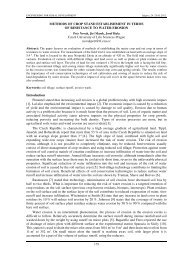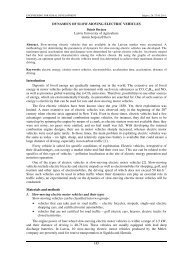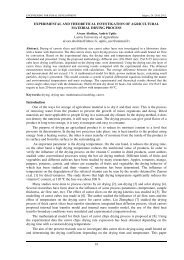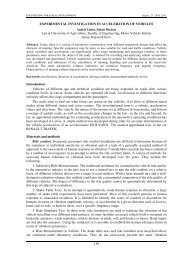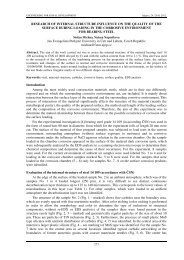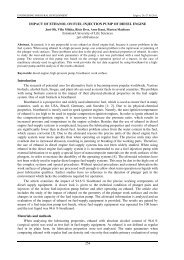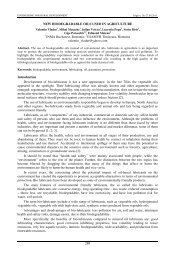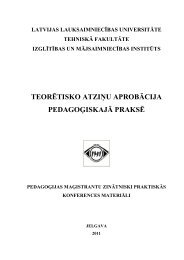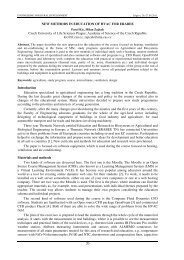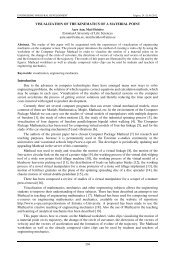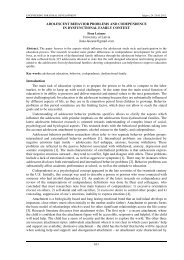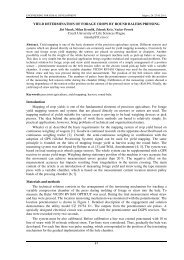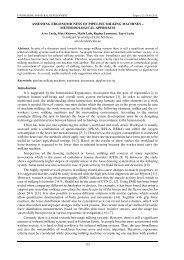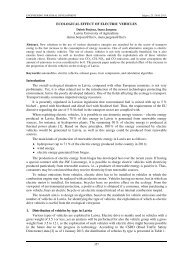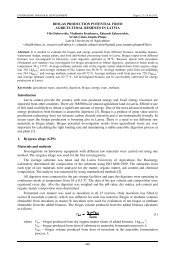Andris Kronbergs, Eriks Kronbergs, Ritvars Rozinskis Latvia ...
Andris Kronbergs, Eriks Kronbergs, Ritvars Rozinskis Latvia ...
Andris Kronbergs, Eriks Kronbergs, Ritvars Rozinskis Latvia ...
Create successful ePaper yourself
Turn your PDF publications into a flip-book with our unique Google optimized e-Paper software.
ENGINEERING FOR RURAL DEVELOPMENT Jelgava, 24.-25.05.2012.<br />
Materials and Methods<br />
In the experiments common reed stalks with moisture 10 % and stalk material density<br />
615 kg·m -3 were used. In the common reed bundle cutting experiments bundles with the height within<br />
1.2 – 1.5 m, upper diameter – 0.08 m, lower diameter – 0.18 m were used. The bundles were harvested<br />
in Pape lake with Seiga harvester.<br />
For common reed bundles primary shredding the wood chipper Tuenniseen GM-10 was used. The<br />
machine was equipped with a 10 kW electric motor and feeding system with hydraulically adjustable<br />
rotational speed. The average particle length for the shredded material is 20 ± 10 mm. For shredded<br />
material comminuting the hammer mill Peruzzo Export 200 was used. The machine was equipped<br />
with a 15 kW electric motor and eight different screens with the round hole size within 1 and 20 mm.<br />
The bulk density for comminuted common reed material was measured according to DD CEN/TS<br />
15103.2005.<br />
The material testing machine Zwick TC-FR2.5TN.D09 with force resolution 0.4 % and<br />
displacement resolution 0,1 µm and the maximal force for testing 2.5 kN is used for comminute<br />
common reed stalk material compacting. The material testing machine was equipped with<br />
compression cell (Fig. 1) which consists of a cylinder and piston which was connected to the<br />
continuous force and displacement measuring equipment. In the compacting experiments the<br />
comminute reed material was placed into the cylinder and pressed with the piston up to 0.17 MPa. For<br />
all experiments the displacement speed of the piston did not exceed 0.05 m·min -1 . The displacement<br />
and stress data were collected and processed by using Zwick software program TestXpert V9.01. The<br />
material density was calculated by using the primary bulk density, material volume and piston<br />
displacement values for all kinds of comminuted materials.<br />
The material density was calculated:<br />
Fig. 1. Compression cell<br />
ρ ρ + ∆ρ<br />
= 0 (1)<br />
where ρ – material bulk density, kg·m -3 ;<br />
ρ0 – comminuted material density, kg·m -3 ;<br />
∆ρ – bulk density increase depending on compacting pressure, kg·m -3 .<br />
The material density dependence on the hammer mill screen mesh size was calculated:<br />
where D – hammer mill screen mesh size, mm;<br />
258<br />
( D)<br />
ρ = f<br />
(2)<br />
0<br />
The material density increase depending on the compacting pressure was calculated:<br />
ρ = ρ′<br />
− ρ = f p<br />
(3)<br />
∆ 0<br />
where ρ′– calculated material density in the compacting process, kg·m -3 ;<br />
p – compacting pressure, MPa.<br />
The results of the comminuting and compacting experiments were processed by Microsoft Excel,<br />
TestXpert and MathCAD programs.<br />
( )



